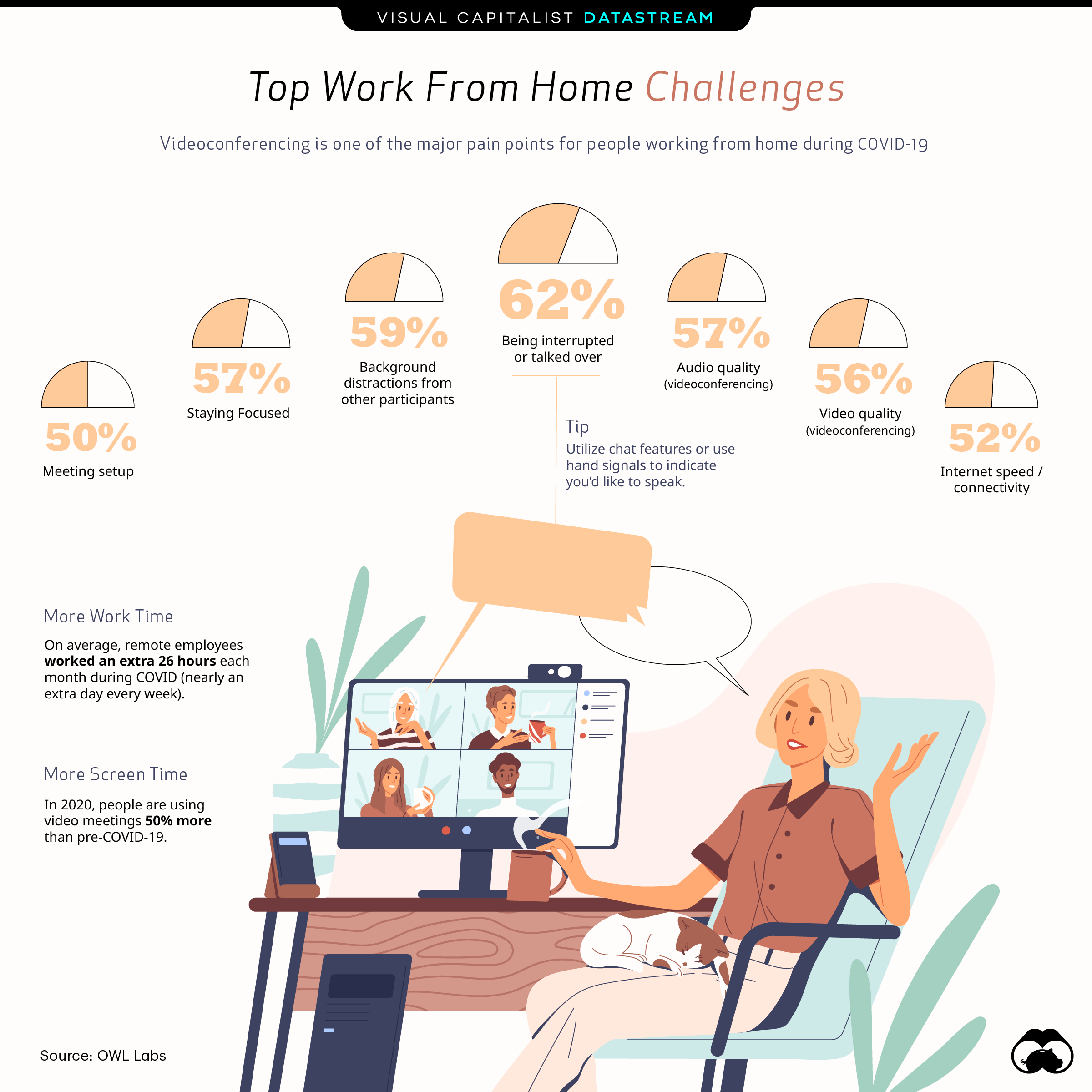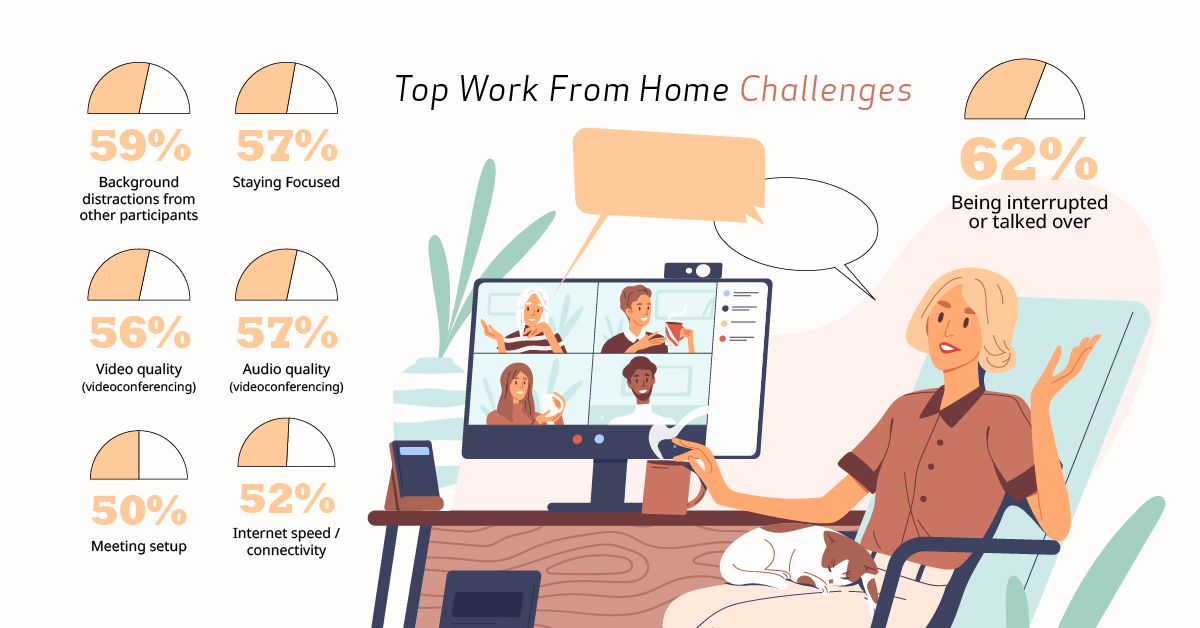Datastream
Sorry, You’re on Mute: The Top Challenges of Working From Home

The Briefing
- The majority of full-time employees in the U.S. are currently working from home. As a result, more people than ever are using video conferencing to communicate with coworkers
- While a third of people surveyed prefer video conferencing over teleconferencing, technical difficulties and virtual etiquette are a major pain point among remote workers
- Being interrupted or talked over is the top complaint, followed by background distractions and audio issues
The Top Work From Home Challenges
In 2020, people are using video meetings 50% more than they did before COVID-19.
According to a recent survey by Owl Labs, this shift to video conferencing has been both good and challenging—while 79% of survey respondents believe video conferencing is just as productive (if not, more productive) than in-person meetings, many of the struggles remote workers face are related to video conferencing issues:
| Challenge | % of Respondents |
|---|---|
| Being interrupted or talked over | 62% |
| Background distractions from other participants | 59% |
| Audio quality in video conferencing | 57% |
| Staying focused | 57% |
| Video quality in video conferencing | 56% |
| Internet speed / connectivity | 52% |
| Meeting setup | 50% |
Because of these challenges, 80% of respondents believe there should be at least one day a week with no virtual meetings.
Working From Home is Worth the Struggle
Despite the challenges that come with remote work, 77% of respondents believe that, when COVID is over, the option to work from home would make them happier.
Why? Money could be a big factor—people are saving approximately $500 per month by working from home.
But remote workers aren’t just saving money, they’re also saving time. By working remotely, employees save an average of 40 minutes per day on their typical commute—that’s 3 hours and 20 minutes a week!
Clearly, the struggles of working from home are worth it—half of the respondents say they would not return to a job that doesn’t offer remote work after COVID-19.
»Want to learn more about how companies and employees are adjusting to WFH Life? Read our full-length article: How People and Companies Feel About Working Remotely
Where does this data come from?
Source: State of Remote Work 2020
Note: This is the 4th annual “State of Remote Work” report by Owl Labs
Datastream
Can You Calculate Your Daily Carbon Footprint?
Discover how the average person’s carbon footprint impacts the environment and learn how carbon credits can offset your carbon footprint.

The Briefing
- A person’s carbon footprint is substantial, with activities such as food consumption creating as much as 4,500 g of CO₂ emissions daily.
- By purchasing carbon credits from Carbon Streaming Corporation, you can offset your own emissions and fund positive climate action.
Your Everyday Carbon Footprint
While many large businesses and countries have committed to net-zero goals, it is essential to acknowledge that your everyday activities also contribute to global emissions.
In this graphic, sponsored by Carbon Streaming Corporation, we will explore how the choices we make and the products we use have a profound impact on our carbon footprint.
Carbon Emissions by Activity
Here are some of the daily activities and products of the average person and their carbon footprint, according to Clever Carbon.
| Household Activities & Products | CO2 Emissions (g) |
|---|---|
| 💡 Standard Light Bulb (100 watts, four hours) | 172 g |
| 📱 Mobile Phone Use (195 minutes per day)* | 189 g |
| 👕 Washing Machine (0.63 kWh) | 275 g |
| 🔥 Electric Oven (1.56 kWh) | 675 g |
| ♨️ Tumble Dryer (2.5 kWh) | 1,000 g |
| 🧻 Toilet Roll (2 ply) | 1,300 g |
| 🚿 Hot Shower (10 mins) | 2,000 g |
| 🚙 Daily Commute (one hour, by car) | 3,360 g |
| 🍽️ Average Daily Food Consumption (three meals of 600 calories) | 4,500 g |
| *Phone use based on yearly use of 69kg per the source, Reboxed | |
Your choice of transportation plays a crucial role in determining your carbon footprint. For instance, a 15 km daily commute to work on public transport generates an average of 1,464 g of CO₂ emissions. Compared to 3,360 g—twice the volume for a journey the same length by car.
By opting for more sustainable modes of transport, such as cycling, walking, or public transportation, you can significantly reduce your carbon footprint.
Addressing Your Carbon Footprint
One way to compensate for your emissions is by purchasing high-quality carbon credits.
Carbon credits are used to help fund projects that avoid, reduce or remove CO₂ emissions. This includes nature-based solutions such as reforestation and improved forest management, or technology-based solutions such as the production of biochar and carbon capture and storage (CCS).
While carbon credits offer a potential solution for individuals to help reduce global emissions, public awareness remains a significant challenge. A BCG-Patch survey revealed that only 34% of U.S. consumers are familiar with carbon credits, and only 3% have purchased them in the past.
About Carbon Streaming
By financing the creation or expansion of carbon projects, Carbon Streaming Corporation secures the rights to future carbon credits generated by these sustainable projects. You can then purchase these carbon credits to help fund climate solutions around the world and compensate for your own emissions.
Ready to get involved?
>> Learn more about purchasing carbon credits at Carbon Streaming
-

 Maps2 weeks ago
Maps2 weeks agoMapped: Average Wages Across Europe
-

 Money1 week ago
Money1 week agoWhich States Have the Highest Minimum Wage in America?
-

 Real Estate1 week ago
Real Estate1 week agoRanked: The Most Valuable Housing Markets in America
-

 Markets1 week ago
Markets1 week agoCharted: Big Four Market Share by S&P 500 Audits
-

 AI1 week ago
AI1 week agoThe Stock Performance of U.S. Chipmakers So Far in 2024
-

 Automotive2 weeks ago
Automotive2 weeks agoAlmost Every EV Stock is Down After Q1 2024
-

 Money2 weeks ago
Money2 weeks agoWhere Does One U.S. Tax Dollar Go?
-

 Green2 weeks ago
Green2 weeks agoRanked: Top Countries by Total Forest Loss Since 2001















